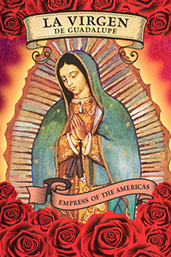
Empress of the Americas
Whether considered as myth or miracle, as fact or fiction, the Virgin of Guadalupe represents the identity of the Mexican nation and, increasingly, of Latin America. That’s the focus of the exhibition, La Virgen de Guadalupe: Empress of the Americas, on display at the Houston Museum of Natural Sciences (HMNS).
Drawing on loans from museums in the United States and Mexico, the exhibition includes historical documents, artifacts and contemporary artwork that illustrate how what Catholics believe is a 1531 apparition has changed from a religious to a political image that symbolizes the Mexican nation.
artifacts and contemporary artwork that illustrate how what Catholics believe is a 1531 apparition has changed from a religious to a political image that symbolizes the Mexican nation.
According to Dirk Van Tuerenhout, the museum’s curator of anthropology who organized the show in collaboration with the Basilica de Guadalupe in Mexico City, the exhibition was also an effort to attract Latino visitors. “The exhibition is the perfect opportunity to reach out to the majority population in Houston,” he said. “We wanted to make them feel welcome here at the museum.”
The initial galleries juxtapose the story of Spain recovering territory conquered by Muslim forces with the rise in the early 14th century of a new empire in central Mexico, that of the Mexica, better known as the Aztecs. In 1519, when conquistadors invade the New World, these two cultures met to create the Mexican nation.
As the story goes, the Virgin appeared to Juan Diego in December 1531 at Tepeyac, a site of Aztec worship to the earth goddess, and asked that a church be built there. To convince the bishop, Juan Diego gathered out-of-season blooming roses from the hillside into his cloak or tilma. But when he unfolded his cloak, in place of the roses, there was an image of the Virgin.
Displayed among early images and texts from the 17th and 18th centuries, a key artifact for history buffs in the introductory galleries is a page from a manuscript known as Nican Mopohua, a document written in Nahuatl, the Aztec language, in which the Guadalupan apparition is recounted. This manuscript is part of the collections of the New York Public Library and rarely travels.
Also on display is one of the earliest books printed in Mexico, the Doctrina Cristiana en lengua Mexicana. Also written in Nahuatl, it is a statement of Christian doctrine for use in missionary work. The Doctrina Cristiana is part of the holdings of the Benson Latin American Collection at The University of Texas at Austin.
At the figurative heart of the exhibition is a chapel-like gallery in which an authorized copy of the tilma is highlighted. The original never leaves the Mexico City basilica, which is considered to be the most visited Catholic pilgrimage site in the world.
The belief that the Virgin had appeared to the Mexican people and, as a contemporary account related, “has not done so for any other nation” fueled a patriotic feeling. Her image evolved from a religious icon to a political one. It was carried by independence leaders such as Miguel Hidalgo and José María Morelos, as well as almost a century later by revolution era figures Pancho Villa and Emiliano Zapata. In the 20th century, United Farm Workers president César Chávez organized California grape pickers under her banner.
Modern devotion to the Virgin in Mexico and Latino communities in the United States has transcended both the orthodox religious and the political presentations. The contemporary works of art that conclude the exhibition reflect personal piety within the private setting of a home: For example, crocheted bedspreads allowed their makers to sleep under the Virgin’s protection every night. Epitomizing Guadalupe’s border-crossing power is the “Project for the flag of a Mexican Colony” By Adolfo Patiño. The image is woven wool, depicting stripes and blue field of the American flag, but in place of its stars are three images of the Virgin of Guadalupe. Her image is also altered, however, with her cloak appearing in three different colors, red, green and yellow, each representing the colors of the Mexican flag.
“Regardless of your personal take on this story, we invite visitors to the exhibition to consider the history and reality surrounding the apparition.” says exhibition curator Van Tuerenhout. “She is, in both image and name, the patroness of hundreds of millions of people…. She is The Virgin of Guadalupe, the Empress of the Americas.”
La Virgen de Guadalupe: Empress of the Americas is on display at the Houston Museum of Natural Sciences (HMNS) through September 5, 2016.
John Coppola